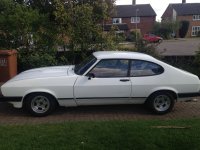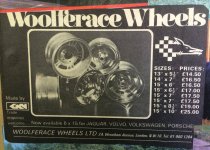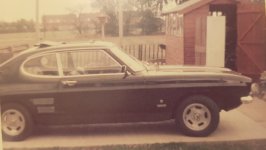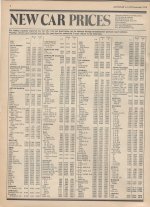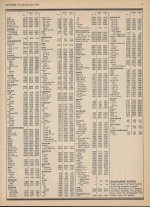Final offering for 1970 was "Laguna Gray". It appears "Laguna Blue" had run its course so they just decided to re-use the name and change the color to Gray. Who would really know? Only every Corvette guy who owns one or the other, that's who. Well by 1970 Laguna Seca raceway up in Monterey was hosting the likes of Parnelli Jones, who took the checkered flag in his Boss Mustang at their Trans-Am event. Dan Gurney also ran in his AAR Cuda but a transmission failure put him out of the race on his 21st lap. 1970 when all the true Trans-Am cars were built and limited but streetable versions were offered to the public, which are some of the most coveted muscle cars today. But back in 1970 there was no doubt that Corvette was still B.M.O.C.
1971 and the gas crunch was still unheard of so performance was the order of the day. "Mille Miglia Red" was the first offering and owed its name to the Mille Miglia (Thousand Mile) Endurance Race held in Italy from 1927 to 1957 starting in the town of Brescia to Rome and back. 1,500 km or about 1,000 Roman miles. The race drew crowds in excess of five million and much to the delight of locals, Italian drivers won 21 years of the 30 year run. But, once again no surprise when, in 1955 Briton Stirling Moss appeared and piloted his Mercedes Benz to victory over his Italian counterpart. Geez, ....that guy was good. After a series of crashes and deaths involving both drivers and spectators the Mille Miglia was cancelled in 1957.
1971 also brought us "Brands Hatch Green" where we skipped back across the pond to borrow a name. Brands Farm in West Kingsdown, Kent, England was the site of a dirt cycle track beginning in 1926, soon motorcycles began racing there on a regular basis. World War II brought some pretty heavy damage to the old track but after the war people wanted to continue racing and, by 1950 the British Racing and Sports Car Club convinced the owners that the future of the track lay in car racing. The money was raised, the track was paved and on 16 April, 1950 the 1.2 mile track was opened and the first race was held. Among the drivers was a very young Stirling Moss. Grand Prix and Indy events have been run at Brands Hatch from 1960 to the present. Euro NASCAR and motorcycle events currently run there as well.
Third color offered for 1971 was "Steel Cities Gray" which represents the area around Pittsburgh, PA. rather than a single track. The Steel Cities Region SCCA is the driving force behind the various road courses in the area since 1950. They sponsored hill climbs at Sewickley, organized the Cumberland Races, a number of races at Connellsville on their airport circuit, the Polish Mountain Hill Climb in Flintstone, MD. and an endless array of road rallies ....and they're still out there.
Lastly for 1971 is "War Bonnet Yellow" one of the more obscure labels but it definitely had a race connection. War Bonnet Park Raceway was a short-lived track opened in 1966 at Mannford, Oklahoma, 25 miles west of Tulsa. Originally a very short one mile track, it was lengthened to accommodate the Trans-Am series in 1968. That was the year James Garner made a surprise appearance and rode along with Don Yenko for his victory lap in his L88 Corvette. However just three short years after opening it was all over for WBPR. A culmination of many things caused the closure including the ever present financial issues involved in the sport but the final blow came when the Keystone Lake Reservoir was built and the town of Mannford was moved to higher ground. The track closed in 1969. Portions of the dilapidated asphalt are still around the area which now has a few residential homes and a trailer park.
1972 was pretty much the last year for the raceway connection to Chevrolet's coloring scheme and they went out with three memorable offerings. The first of which was "Bryar Blue" a beautiful teal considered by many to be one of the nicest colors ever applied to a C3 Corvette. Bryar Motorsports Park opened in 1964 by owner Keith Bryar in Louden, New Hampshire. Within two years the track was added to the SCCA Trans-Am schedule but motorcycle racing was the real bread and butter at Bryar. By 1989 lack of investment and upkeep had taken its toll on the track and it was sold and completely revamped to become the current New Hampshire Motor Speedway.
"Elkhart Green" was a vibrant new color for '72 but a re-used name from 1967 when it was Blue. This of course brings us back to Road America at Elkhart Lake, Wisconsin where George Follmer piloted his Porsche 917 to victory for Team Penske in the (lawless) Can-Am race for 1972 and Graham McRae won the F5000 in his GM1-Chevrolet.
Final offering for 1972 and the last of a proud history of Chevrolet color branding was "Targa Blue" which brings us back to Italy, the mountains of Sicily to be more precise, near the capitol of Palermo. The Targa Florio was an endurance race started in 1906 and lasted for 71 years. The race was created by wealthy race enthusiast Vincenzo Florio. After several victories Porsche named it's hard top convertible 911 after the event. Once again the majority of wins went to Italian drivers and after several fatalities this race went the same way as the Mille Miglia before it and was closed down in 1977.
While the Corvette color name "Mille Miglia Red" managed to linger on until 1975, all other references to motorsports in Corvette's paint schedule had ceased to exist. The times had changed and the most exciting era in automobile history had come to an end.
It may not seem like that big of a deal to many, but the next time you look at the trim tag on your vintage Corvette, it's OK if your chest swells with a touch of pride knowing the connection between that paint code and some of the finest men, the most thrilling venues and the funnest time in motorsport history.
By Greg LaRiviere Vette-Vues June / July 2023

